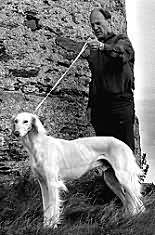|
|
|
|
|
|
|
enigma enchantment illusion and incandescence From ancient Egypt to the start of the second millennium. With 6,000 years of history as the breed's heritage - our lifespan is but the blink of an eye. |

|
|
Introduction
Photographing dogs requires special techniques. The best shots are obtained when the dog is looking interested and attentive. In addition, the Saluki dogs in the photo-exhibition are all pedigrees and are obedient since they have been trained for the show ring. All these factors contribute to the successful composition of the photographs. Basic composition techniques The dog should be comfortable. Many a good shot was spoiled because the dogs were cold. Although the animal could be persuaded to stand, their expressions were fixed and wooden. Also the dogs should be interested in their environment. If the dog enjoys roaming in the woods it will usually have a more interested and attentive expression if it is photographed there. It is usually better to photograph the dog after it has been exercised. It is more likely to stand if it is feeling tired (but not exhausted!). Squeaky toys are useful devices for holding the dog's attention and dog biscuits are a useful bribe. With the water reflection shot the dog's attention was held by merely throwing stones into the water. The actual setting up of the dog is usually best left to an expert in the breed, usually the owner. Comparing the "top line", "fronts", "fringing" and stopping the animal from being "rocking horsed" is way beyond the average photographer! Professional dog breeders want more from their photographs than just a wagging tail and wide eyes! Photographic Materials A fast film of 400 ASA is essential. It gives high shutter speed and a good depth of field. Essential factors, as you often need to grab the moment. Kodak TMAX PRO 400 ASA was used for all the photos in the gallery. The film grain can be held to within acceptable limits, even with the bigger enlargements. Kodak TMAX film developer was used and provided good contrast and tonal range, although in certain instances the blacks tended to clog up and lose detail when printed. Ilford multigrade paper and filters were used in conjunction with a LPL diffuser enlarger fitted with a NIKON enlarger lens. A good solid installation is essential, especially for the really big enlargements projected onto the floor. © 1999 Kevin Walker-Smith. |
|
 Photographing Salukis
Photographing Salukis